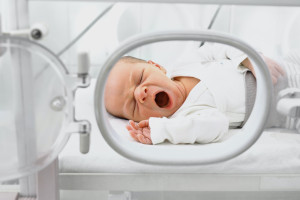In 2025, the birth rate will drop again by several thousand. "This is not a crisis, but a challenge."

- For several years now, the number of deaths has exceeded the number of births. Every year, a city the size of Zielona Góra disappears from the map of Poland.
- In 2024, the average Polish woman would have 1.1 children. For simple generational replacement, this ratio should be at least 2.15.
- Let's not discuss the low fertility rate, but what to do to ensure that women who want to have children can and want to have them if they decide to have them at a later age - emphasizes Professor Irena Kotowska, a member of the Government Population Council.
The two main problems currently indicated by demographic statistics are the declining fertility rate and the simultaneous aging of society - said experts during a discussion at the recent (July 8) meeting of the Parliamentary Team for the Demographic Future of Poland.
The decline in birth rates in Poland has been noticeable since the 1980s. The last baby boom, a period when the number of births increased significantly, occurred in 1983, when 723,000 children were born. After that, the number declined year by year, to 272,000 in 2023 and 252,000 in 2024.
Data for the first quarter of 2025 only confirm the continuing unfavorable trend in the number of births.
- We can already assume that the number of births in 2025 will again be several thousand lower year-on-year - assessed Anna Wysocka, director of the Demographic Research Department of the Central Statistical Office.
For several years, statisticians have been recording negative natural increase. More Poles are dying than being born. In 2024, the population loss was 147,000. By 2021, it has reached approximately 130,000. This is equivalent to a city the size of Zielona Góra or Ruda Śląska disappearing from the map of Poland.
According to EUROSTAT data, the fertility rate of Polish women (statistically the number of children per woman of reproductive age - ed.) in 2023 was 1.16, and in 2024 - 1.1. For comparison - in 1951 it was 3.75, which shows how deep the "collapse" in terms of the number of births is.
- For simple generational replacement , the fertility rate should be no less than 2.15 - emphasized Anna Wysocka.
We are also the fastest-aging society in the European Union. By 2023, over 7.5 million Poles will have reached or exceeded the age of 65, representing 20.1% of the total population. In 1990, older people constituted approximately one-tenth of the population.
Demographic changes pose enormous economic and social challenges for Poland. According to Central Statistical Office (GUS) forecasts, by 2060 the number of working-age people will decline by 34.6% , or by 8 million . The post-working-age population will increase by 23.4% , or by over 2 million . Simultaneously, the country's population will decline to approximately 31 million.
As Dr. Katarzyna Górniak from the Faculty of Administration and Social Sciences at Warsaw University of Technology pointed out, experts possess broad and in-depth knowledge of demographics, which they convey to decision-makers in the form of various analyses. The problem is that this knowledge is used only ad hoc.
So far, the actions taken have proven ineffective. "The way out of this situation is to accept that our problem is not low fertility or an aging population, but the lack of an appropriate response to these phenomena in social and healthcare policy," she said.
Read also (archived text):
Demographic changes – drama or process?Can we meet these challenges? As Professor Irena Kotowska of the Warsaw School of Economics, a member of the Government Population Council, pointed out, Poland's demographic situation is currently often portrayed as exceptionally unfavorable and dramatic, but without reference to global demographic trends.
"The key is to understand that we are at a specific stage of transformation, affecting a growing number of countries. More than half of the world's population now lives in countries where the fertility rate is below the simple replacement rate of 2.1," the professor explained.
A critically low fertility rate is considered to be a drop below 1.5 children per woman. "We belong to a group of European countries struggling with low fertility. However, Poland stands out in this group because such a low rate persists and is unlikely to change significantly in the near future. However, we must do everything we can to halt this decline," emphasized Professor Irena Kotowska.
Fertility rates below replacement level began to decline in Northern European countries in the late 1960s and 1970s, but until recently, in the last decade, the fertility rate in these countries was never low, meaning it never fell below 1.5. However, Central and Eastern European countries, which joined this trend in the 1990s, experienced a more dramatic and shorter decline. After 2018, we entered another phase of decline.
As the professor said, women's later decision to have children has a significant impact on low fertility rates. In some countries that experienced a decline in fertility but later partially recovered, childbearing was delayed, while births were compensated by an increase as women entered a slightly older age group. In Poland, this "rebound" was very weak.
Professor Irena Kotowska urged us to utilize this knowledge. "So let's not discuss the low fertility rate, but rather what can be done to ensure that women who want children can have them if they decide to have them later in life," she said.
She noted: "Especially since we analyze the responses of Polish women and men to the question about how many children they want to have, it shows that the average number of children they have is smaller than the number they would like to have. This is a very important finding that allows us to suggest certain solutions."
Uncertainty influences procreative decisionsA phenomenon that should also be noticed by decision-makers is the ongoing change in family models. Families with children based on unmarried couples are playing an increasingly important social role. Their number has almost tripled in the last decade. One in 10 children is raised in such an informal family.
- If we are talking about policies supporting fertility and formulating goals, we cannot ignore this fact, and it is not present in discussions - the professor noted.
According to Professor Irena Kotowska, reproductive health should also be supported, not only through access to public infertility diagnostic and treatment programs, but also through education.
- We will emphasize that today family planning is not only about contraception, but also solutions that allow parents to have children when they decide to have them - she said.
She also noted that research conducted among women aged 20-39 shows increased uncertainty as a factor related to reproductive decisions. A significant component of this uncertainty is the abortion law in Poland and the lack of trust in existing systemic solutions needed when families find themselves in difficult situations. "This is a very important factor in delaying the decision to have a child," the professor emphasized.
Inga Domagała, Director of the Department of Demography at the Ministry of Family, Labor and Social Policy, admitted that it's not fully known what drives Polish women and men to decide against parenthood or to settle for just one child. Hence, ongoing or planned research is underway to answer this question.
"It's not a crisis, but a challenge"Sociological research paints a different picture of women than it did in the 1990s. "Women are better educated and ambitious. They don't want to be dependent on men. They don't sacrifice their personal professional ambitions for the sake of being a mother. They want to be one, but they struggle to combine these roles. Therefore, it's important to create conditions for women that make this easier," said Dorota Gierej, deputy director of the Department of Family Policy at the Ministry of Family, Labor and Social Policy.
In the opinion of Professor Irena Kotowska, it is necessary to change the narrative about the problem of low fertility and an aging society.
"The fact that the Polish population is aging isn't a crisis, considering the increased life expectancy or the fact that many retirees remain healthy enough to continue working. An aging population is a challenge, but not a threat, because that will only arise if we fail to adapt to inevitable changes," she said.
The professor also called for a broader, rather than fragmented, perspective on family-friendly policies. "The 800+ program alone won't increase the birth rate. Rather, we should discuss how to broadly improve the quality of life and make it easier for families with children, because any actions in this direction can translate into reproductive decisions," she emphasized, urging that low fertility rates be viewed not as a crisis but as a challenge. This is a problem not only Poland is grappling with.
Copyrighted material - reprint rules are specified in the regulations .
rynekzdrowia













